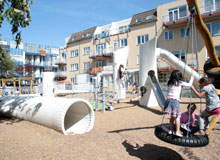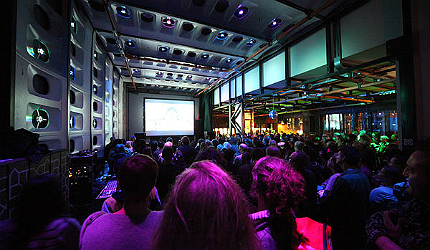

As environmental issues become ever more important in our society, interior designers are increasingly looking to make their interior pieces more eco friendly. While many designers choose to incorporate sustainably sourced wallpaper, clay paints or organic fabrics into their designs, few have taken the route of the Netherlands-based company, 2012Architecten, who merge sustainability and innovative designs using reclaimed materials.
Led by directors Jan Jongert, Césare Peeren and Jeroen Bergsma, 2012Architecten was founded 15 years ago when eco design and sustainability was not as widely known as it is now. This focus on sustainability has led to some unique, mad-cap designs, including a dance floor made out of desks, windmill blades masquerading as a playground and an office decorated with old ceiling tiles and teddy bears.
When you start throwing teddy bears and windmills into the mix many would say you risk being labelled as quirky or kitsch. 2012Architecten certainly don’t worry about being quirky, in fact they wear their quirky label with pride, regarding their innovative designs as a more "playful" way of promoting environmental issues.
Superuse – redesigning waste
To understand 2012Architecten you first have to understand Superuse, their primary concept that affects every aspect of their business. "Superuse is the transformation of wasted materials, components and elements into a new purpose, giving it a secondary not pre-purposed [sic] life," said director of 2012Architecten, Jan Jongert.
After the initial design period, the team research various sources of material in the local area and plot them on a harvest map, which shows potential materials and their distance from the building site. The aim of the map is to limit transport distance to reduce energy.
Since the final designs of their projects will always be influenced by what building materials they can find at the time, the team have to prepare for the fact that their designs are constantly in flux and may have to be changed once the materials are found. Jongert describes this stage in the project as a "parallel process".
One of the company’s more complex projects was the design and construction of a residential villa built for a couple to showcase a collection of paintings. Around 60% of the villa was made from reused materials, including the villa’s kitchen drawers, which were made out of old billboards, as well as the curtains, which were made out of greenhouse foil.
Another of the company’s more complex projects was the redesign of avant-garde arts and culture institute WORM. After overcoming various restrictions that came along with the 19th century building, the team created the perfect home for the institute. They used reclaimed parts of an Indonesian Airlines Airbus for the concert hall and reused rolling photo archive cabinets found in the basement as furniture.
Hajo Doorn, director of WORM, said: "We didn’t know when we were starting or how it would look like in the end and that’s a very dynamic way of dealing with architects."
It seems understandable that many would feel slightly concerned when faced with the idea of being surrounded by used materials. Jongert says he has noticed many of his clients have the same reaction: "In the beginning people react awkwardly … to the idea of using waste, but when we design we always find a new aesthetic and patterns with those materials and components, not revealing their origin in the first instance, but creating a new layer in the new function. People react positively and surprised when they discover the origin and depth."
Although challenging, the experience of working with reused materials is certainly not something that Doorn regrets, saying: "It is fun to do it and to be environmentally friendly doesn’t mean it has to be boring."
Transforming waste, transforming attitudes
Although the redecoration of interiors for homes or businesses are usually purely for aesthetics, using reclaimed or recycled materials can have as positive effect on the environment as reusing materials saves energy which would have been wasted creating new materials.
On 2012Architecten’s talent for using reclaimed materials, Jongert explains: "Our strength is that we look at what people find discarded and ugly and waste and transform that into new aesthetical products."
The terms eco-friendly and green design have not always been as popular as they are now. Jongert knows this all too well and reflects on the changes that have occurred during his time in the industry.
"When we started 15 years ago there was not much interest in these thoughts … the whole concept of recycling resources has pretty much changed," Jongert says. "I think there is a much bigger understanding about this."
The change in attitudes towards eco issues has seen 2012Architecten’s business increase year by year. "It has also changed the kind of projects that we are involved with so we started with very small interiors and more art-like projects and grew to really big interiors and buildings."
Taking responsibility for green design
Along with its followers eco design also has its critics. The main criticism of eco design is that it puts politics before design, creating a clash between green and good design. Jongert strongly disagrees with this stance, stating that bad design is not limited to "conscious" designers.
"You have very bad green design and very bad non-conscious design as well and there is also very good design that doesn’t take care of anything. Design, I think, is about creating added value and in every process this is possible, the difference is the responsibility you take as a designer.
"It takes maybe a bit more effort to deal with all the contexts you have to take care of and to understand about it and that’s not something that designers are taught very much about in their education, but I think this is a new way to go."
Another criticism of eco design is that it can be expensive to buy green products or make your home eco friendly, and in this economy many people may not want to spend money redecorating their homes in a sustainable and eco friendly way when redecorating is already seen as a luxury.
Jongert agrees that for many people, converting to an eco friendly lifestyle can be expensive, but he sees a way around it: "As soon as you find people in your neighbourhood that are a bit handy and you have material to supply, you can, on a very small scale, transform your direct environment, so I think that’s much more interesting."
The design skills and knowledge of 2012Architecten might seem quite daunting to replicate, but the company wants to make it as easy as possible for ordinary people to make their homes eco friendly and sustainable using reclaimed materials.
"We are working on a digital ‘harvest map’ so that other designers as well can see what materials are available," Jongert explains. "Because it is connected to superuse.org, you can get inspiration from other products that are being designed and gain the knowledge to make it possible to obtain these materials that would otherwise be hidden."
"That is something that we think is essential, that materials should not be privatised after they are harvested. They are returned, in a way, to the public."



